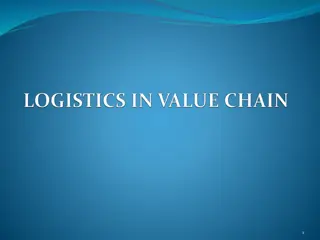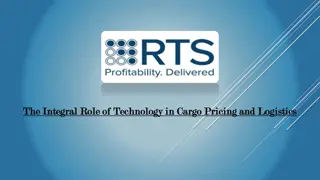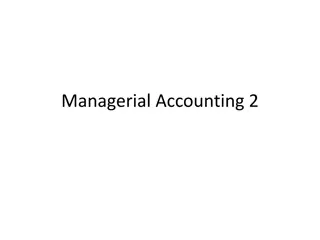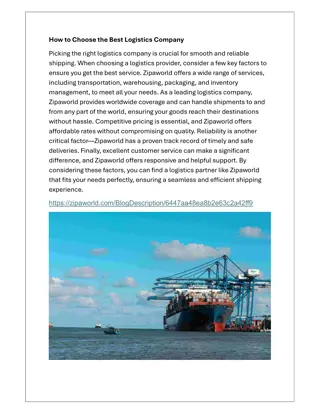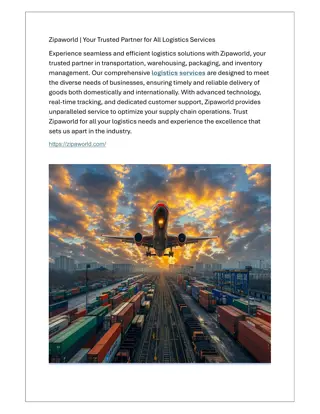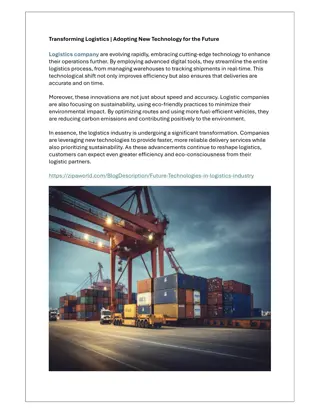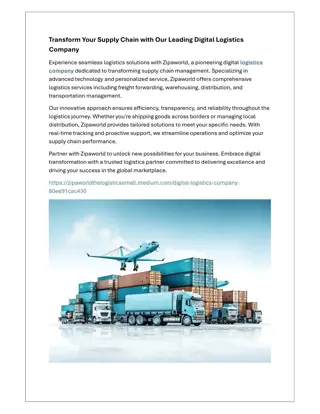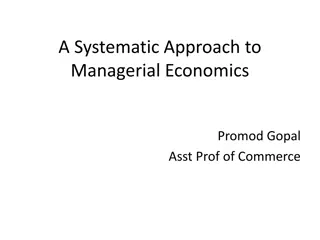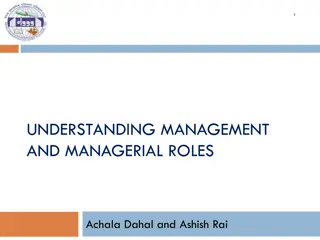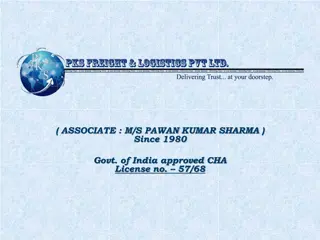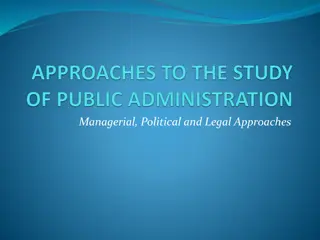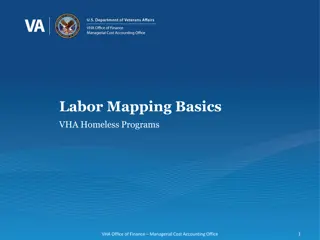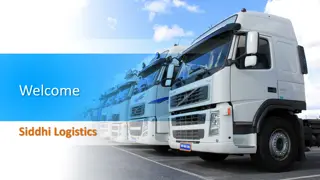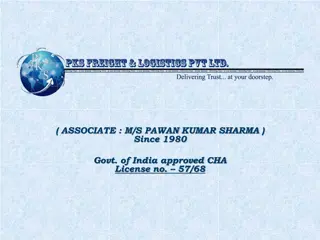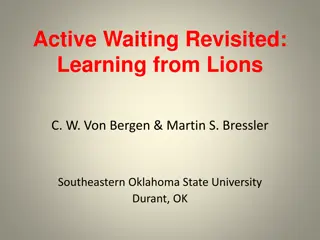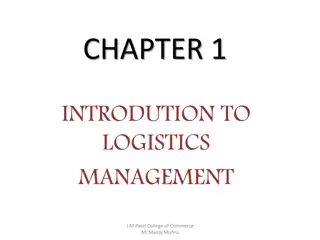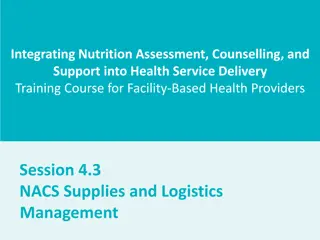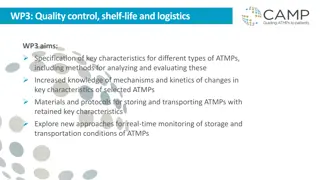Organizational and Managerial Issues in Logistics
This chapter delves into various organizational and managerial issues in logistics, covering topics such as organizational structure, productivity, quality, theft management, logistics social responsibility, reverse logistics, and programs to counter terrorism impact on logistics. Key terms and concepts related to decentralized and centralized logistics organizations, security protocols, theft prevention, and quality management are discussed, providing a comprehensive overview of logistics operations and management strategies.
Download Presentation

Please find below an Image/Link to download the presentation.
The content on the website is provided AS IS for your information and personal use only. It may not be sold, licensed, or shared on other websites without obtaining consent from the author. Download presentation by click this link. If you encounter any issues during the download, it is possible that the publisher has removed the file from their server.
E N D
Presentation Transcript
CHAPTER 4 Organizational and Managerial Issues in Logistics
Learning Objectives To examine organizational structure for logistics To learn about traditional and contemporary organizational design for logistics To explore productivity issues in logistics To explore quality issues in logistics To learn about ways to manage theft and pilferage 4-2
Learning Objectives To introduce you to the concept of logistics social responsibility To discuss issues associated with reverse logistics To describe programs designed to lessen the impact of terrorism on logistics systems 4-3
Organizational and Managerial Issues in Logistics Key Terms Decentralized logistics organization Excess capacity Fragmented logistics structure Importer Security Filing (ISF) rule C-level position Centralized logistics organization Container Security Initiative (CSI) Customs Trade Partnership Against Terrorism (C-TPAT) 4-4
Organizational and Managerial Issues in Logistics Key Terms Pilferage Productivity Reverse Logistics Tachograph Theft ISO 9000 Lean Six Sigma Logistics service quality Logistics social responsibility Logistics uncertainty pyramid model 4-5
Organizing Logistics within the Firm Two key organizational logistics topics Organizational structure Organizational design internal relations, level of cooperation ... responsibility ... 4-6
Organizational Structure for Logistics Two basic organizational structures are: Fragmented logistics structure Logistics activities are managed in multiple departments throughout an organization Unified logistics structure Multiple logistics activities are combined into and managed as a single department Business model ... types of products
Organizational Structure for Logistics Two basic organizational structures for logistics departments are: Centralized logistics organization Company maintains a single logistics department that administers the related activities for the entire company from the home office Decentralized logistics organization Logistics-related decisions are made separately at the divisional or product group level and often in different geographic regions Economic aspects = cost + unified log. policy Flexibility ......? + combination 4-8
Organizational Structure for Logistics Job title or corporate rank Leading edge organizations tend to head the logistics department by senior-level personnel Generally excluded from holding a C-level position 4-10
Organizational Design for Logistics Three primary types of organizational design include: Hierarchical (functional) Top-down flow Matrix Cross-functional responsibilities Network Process philosophy focused on combining tasks into value-creating products and activities 4-10
Organizational Design for Logistics Network organizational design is manifested in terms of: Relevancy Refers to satisfying current and emerging customer needs Facilitated by developing mutually beneficial relationships with key customers At a minimum, these relationships should provide an understanding of customer needs and wants 4-11
Organizational Design for Logistics Network organizational design is manifested in terms of: Responsiveness Reflects the degree to which an organization can accommodate unique or unplanned customer requests Achieved when the appropriate decision markers are provided with both relevant information and the authority to address unique or unplanned requests 4-12
Organizational Design for Logistics Network organizational design is manifested in terms of: Flexibility Is an organization s ability to address unexpected operational situations Predicated on avoiding early commitment to an irreversible course of action 4-13
Managerial Issues in Logistics Productivity Quality Risk Sustainability Complexity 13-14
Productivity Can be defined as the amount of output divided by the amount of input Provides insight into the efficiency with which corporate resources are being utilized For example: 200 trucks in Distribution Centre 150 trucks out = 200/150 = 0,75 x 100 = 75 % productivity The same in Euro or USD. 4-15
Worker Productivity Warehousing and transportation are heavily dependent on human labor Human labor is an input (i.e. workers receive wages or salaries) Productivity improvement efforts in logistics are often directed toward increasing the amount of output while holding input constant (workers.....robotization) ... Change of job characteristics 4-16
Asset Productivity Asset-related productivity concerns include: Space utilization Excess capacity Unused available space Can be unproductive as it may result in the purchase of additional equipment or facilities which adds costs (input), but may not yield additional output resulting in a productivity decline Improving the output from existing assets Increases productivity as inputs remain constant, but output is increased Max. utilization 24/7 4-17
Quality Logistics service quality Relates to a firm s ability to deliver products, material and services without defects or errors to both internal and external customers Ordered quantity + well packed + all documents + disired time 4-18
Quality ISO 9000 Is a set of generic standards used to document, implement, and demonstrate quality management and assurance systems Is applicable to both manufacturing and service firms Standards are intended to help companies build quality into every core process in each department 4-19
Quality ISO 9000 Firms demonstrating commitment to quality through training, reviews, and continuous improvement achieve initial ISO 9000 certification Once certification is obtained, audits are conducted annually and organizations can be recertified every 3 years Certification is credited with an increase in customer service improved order accuracy enabling enhanced costs analysis 4-20
Quality Six Sigma (or six standard deviations) Is a quality focused methodology that emphasizes the virtual elimination of business errors Area covered under a normal curve is by six standard deviations is 99.999% Approach suggests that there will be 3.4 defects, deficiencies, or errors per one million opportunities Can be applied to various logistics activities such as order picking 4-21
Quality Six Sigma (or six standard deviations) Benefits Reduced costs Reduced errors and waste Reduced cycle time Drawbacks Overcoming business cultural barriers Investing required resources (both human and money) Gaining top management commitment 4-22
Quality Lean Six Sigma Is a quality focused methodology that integrates Six Sigma with the Lean approach Integrates the goals and methods of these two approaches in pursuit of quality Unique because it recognizes that organizations cannot focus only on quality or speed Emphasizes an organizational focus on improving quality as it relates to responsiveness 4-23
Risk Can be viewed as susceptibility to disruptions that could lead to a loss for a firm Can take a variety of forms as it relates to logistics management activities Regularly occurring (or operational) risks, i.e. variability in demand or potential for a damaged shipment Catastrophic risks, i.e. earthquakes or terrorist attacks 4-24
Risk Logistics Uncertainty Pyramid Model Established to identify uncertainty sources that can affect the risk exposure for logistics activities Identifies several types of uncertainty including shipper, customer, carrier, control systems, and external 4-25
Risk Terrorism is an example of catastrophic risk Terrorism can be defined as an illegal use of or threat of force or violence made by a group or individual against a person, a company, or someone s property with a goal of menacing the target, often grounded in politics or ideology. 1 4-27
Risk September 11 terrorist attacks have impacted logistics practices on a worldwide basis Greater attention given to: Processes Procedures Activities 4-28
Risk 22 separate government entities were incorporated into DHS Transportation Security Administration (TSA) Transportation Worker Identification Credential (TWIC) Customs and Border Protection (CBP) Container Security Initiative (CSI) Customs Trade Partnership Against Terrorism (C-TPAT) Importer Security Filing (ISF) rule also known as 10+2 (example in Table 4.2) 4-29
Table 4.1: Timeline for Presenting Electronic Advance Manifest Information 4-30
Risk Theft is an example of an operational risk Theft (stealing) can be defined as the taking and removing of personal property with the intent to deprive the rightful owner of it. Thoughts regarding theft Insurance companies may reimburse for loss, but time and costs tend not to be covered Theft results in the planned flow of goods being interrupted which can lead to stockouts Theft can factor into facility location decisions 4-32
Risk Thoughts regarding pilferage (employee theft) Transportation and warehousing operations are particularly vulnerable to pilferage Managing pilferage begins with the hiring process Zero tolerance pilferage policy Keep goods moving through the system Recent increase in pirate attacks 4-33
Sustainability Logistics Social Responsibility Corporate social responsibility issues that relate directly to logistics Potential dimensions include: Environment Ethics Diversity Safety Philanthropy Human rights Others 4-34
Sustainability Reverse logistics Is the process of managing return goods Can be 4-5 times more expensive than forward logistics Process can take 12 times as many steps as forward logistics 4-35
Sustainability Reverse logistics process focuses on: Why products are returned How to optimize reverse logistics Whether reverse logistics should be managed internally or outsourced to a third party . 4-36
Complexity Network complexity Is the growing number of nodes and the associated changes to the links in logistics systems Process complexity Centers on the haphazard development of processes, additions and modifications to processes over time, and/or changing process requirements Range complexity Centers on the implications associated with the increasing number of products that most companies continue to face in an effort to differentiate themselves with their customers 4-37



